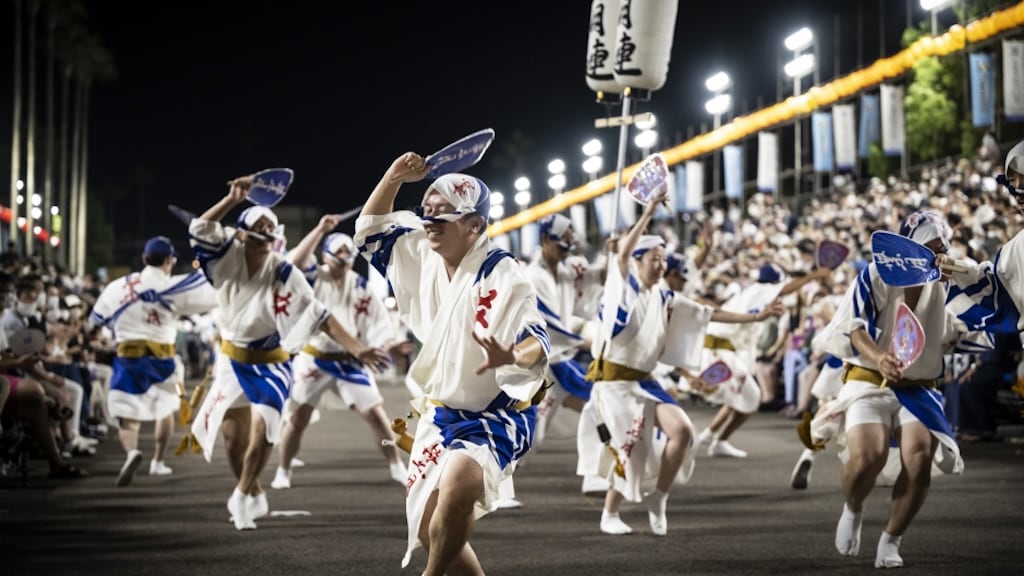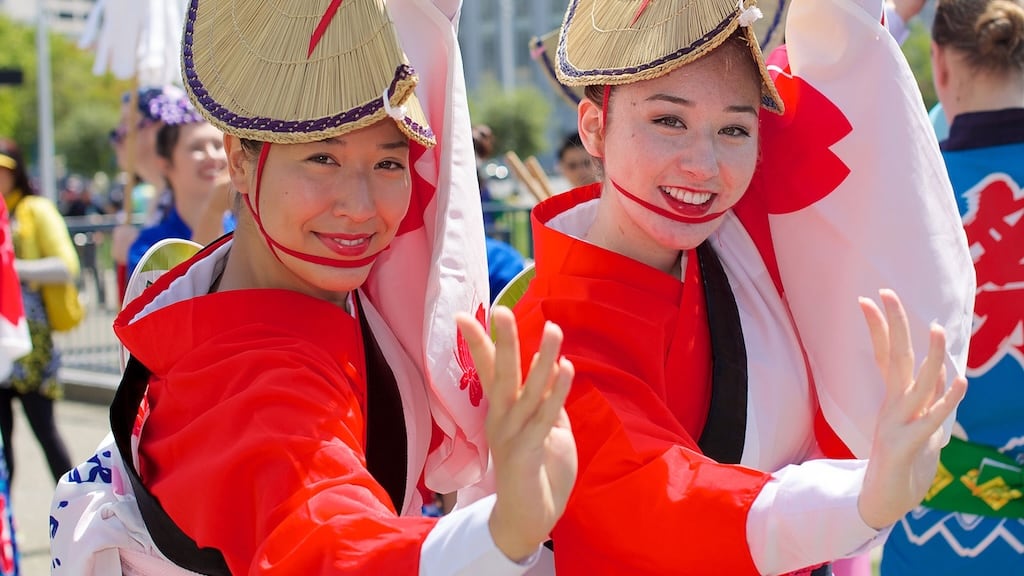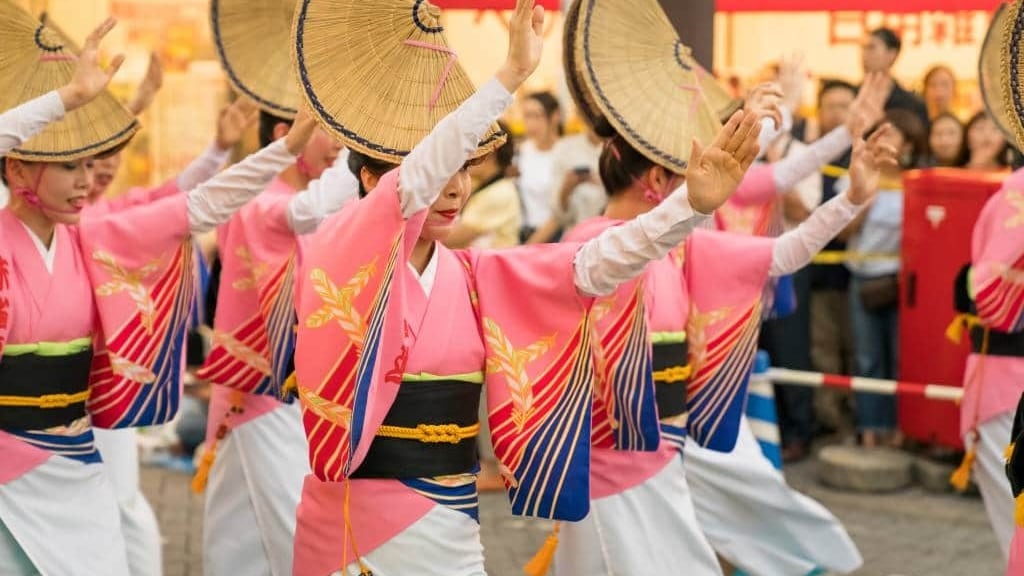The Dance of the Fool: Yielding to Awa Odori's Irresistible Beat
The air on a mid-August evening in Tokushima, Japan, doesn't just feel warm; it vibrates. It hums with the hypnotic, two-beat rhythm of taiko drums, the melodic twang of the shamisen, and the cheerful calls of thousands of voices.
This is the sound of Awa Odori, a spectacle of dance and revelry so immense and infectious that it transforms an entire city into a stage. Much more than a festival, Awa Odori is a 400-year-old celebration of pure joy, a cultural phenomenon that has mesmerized Japan and is now finding its rhythm across the Asian continent.


Echoes of History: From Castle Celebrations to a National Spectacle
Awa Odori traces its origins to 1587 in what is now Tokushima Prefecture, formerly known as Awa Province. The most widely told origin story attributes the festival's beginning to Hachisuka Iemasa, the daimyo (feudal lord) who governed the region. To celebrate the completion of Tokushima Castle, he hosted a grand party, distributing sake to the townspeople. Legend has it that the citizens drank and began to dance with such uninhibited, raw enthusiasm that their joyful, clumsy movements became the foundation for the dance.
It was during this wild celebration that the festival's famous mantra was born: "Odoru aho ni miru aho, onaji aho nara odoranya son son!" – "The dancers are fools, the watchers are fools. If both are fools, you might as well dance!" This philosophy of joyful foolishness remains the soul of Awa Odori.
Over the centuries, this impromptu street party evolved. Following World War II, as Japan sought to rebuild its cultural identity, Tokushima's business leaders and officials saw the festival as a way to boost morale and tourism. They formalized the event, established rules for the dance troupes (known as ren), and promoted it on a national scale. This effort successfully transformed Awa Odori into Japan's largest and most famous dance festival, attracting more than a million visitors annually.
The Anatomy of the Dance: Ren, Rhythm, and Regalia
The heart of the festival is the dance itself, performed by dozens of organized troupes called ren. These groups, some with hundreds of members, practice year-round to perfect their choreography, music, and formations. While each ren has its unique style, they all adhere to two primary dance forms.
- Otoko Odori: The men's dance is dynamic and powerful. Dancers wear happi coats or yukata hitched up to their knees, often carrying paper fans (uchiwa) or small lanterns (chochin). They crouch low to the ground, their movements energetic and sometimes acrobatic, embodying a spirit of boisterous freedom.
- Onna Odori: In striking contrast, the women's dance is a picture of grace and precision. Dressed in elegant matching yukata, formal geta sandals, and the iconic half-moon shaped straw hats known as amigasa, the women dance upright with restrained, flowing movements. Their hands move in unison and their steps are perfectly synchronized, creating a mesmerizing wave of color and form. The amigasa are worn so low that they obscure the dancers' vision, a testament to the immense skill required to perform in perfect harmony.
Driving it all is the narimono music ensemble, typically featuring a blend of traditional Japanese instruments including the shamisen (a three-stringed lute), kane (a gong), shinobue (a transverse flute), and the commanding beat of the shime-daiko and o-daiko drums. The simple, infectious "chan-ka, chan-ka" rhythm is the festival's heartbeat, a sound so pervasive it seems to emanate from the very cobblestones.
A Festival for All Senses: Food, Sights, and Participation
Awa Odori is a complete sensory experience. The streets of Tokushima are lined with endless rows of food stalls (yatai) offering festival favorites like yakitori (grilled chicken skewers) and takoyaki (octopus balls). Visitors should try local Tokushima specialties, especially anything flavored with sudachi, a small, green citrus fruit that provides a uniquely refreshing tang to everything from grilled fish to chilled drinks.
While smaller performances occur during the day, the festival reaches its crescendo as dusk falls. The main streets are closed to traffic and transformed into massive dance avenues called enbujo. There are both free and ticketed viewing areas. The paid stages (sajiki seki) offer tiered seating and the best views of the most famous ren, but the true, chaotic energy of the festival is often best felt in the free zones, pressed among the cheering crowds.
For those who feel the pull of the "fool's dance," the festival offers a unique opportunity to join in. Several Niwaka Ren are specifically organized for drop-in participants. Anyone, regardless of skill level, can learn the basic steps and join the parade for a block or two, truly embodying the spirit of "odoranya son son!"
Beyond Japan: Awa Odori's Footsteps Across Asia
Though Tokushima remains its heartland, the spirit of Awa Odori has traveled far beyond its borders. Its infectious energy and strong cultural identity have made it a popular ambassador of Japanese culture, with troupes frequently invited to perform at international festivals and cultural exchange events around the globe.
Within Asia, this cultural outreach has found fertile ground. In Taiwan, for example, strong cultural ties with Japan have led to Awa Odori performances being a highlight of Japan-focused cultural festivals. These performances, executed by both visiting Japanese ren and locally formed groups, introduce the dance to a new generation of enthusiasts. Cities such as Kuala Lumpur and Singapore have also hosted Awa Odori troupes as part of larger Japanese cultural expositions, where the vibrant costumes and universal language of dance captivate audiences.
These events are not just performances; they are often interactive workshops where locals can learn the fundamental steps, feel the rhythm, and share in the "fool's joy." This expansion ensures that Awa Odori is not just a relic of the past but a living, breathing art form that continues to evolve and find new homes. The Awa Odori Association often supports these international goodwill tours.


How to Experience the Spectacle
For those planning a trip to Tokushima, preparation is key. The festival runs annually from August 12th to 15th.
- Accommodations: Hotels in and around Tokushima City are booked months, sometimes even a year, in advance. Early planning is essential. Many visitors opt to stay in nearby cities like Okayama or Takamatsu and commute by train.
- Viewing: Arrive early to secure a good spot in the free viewing areas or purchase tickets for the main stages online in advance. Tickets are typically available from June.
- Tips: Wear comfortable shoes, stay hydrated, and be prepared for large crowds.
Above all, let go of your inhibitions. Whether you watch from the sidelines or jump into a Niwaka Ren, the key is to surrender to the rhythm.
A Legacy of Joy
Awa Odori is more than Japan's largest dance party. It is a powerful connection to a 400-year-old history, a celebration of community, and a testament to the resilient power of joy.
It is a festival that reminds us that in a world that is often too serious, there is profound wisdom in embracing a moment of foolish, uninhibited dance. It is a pulsating, living piece of Japanese heritage that continues to capture hearts, not just in its homeland, but across the continent and the world.